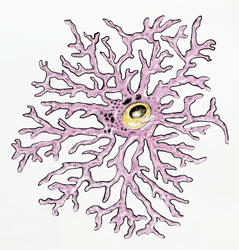Astroglial cells in epilepsy
Astroglial cells represent the most numerous cell type in the central nervous system (CNS), and accumulating evidence indicates their involvement in fundamental mechanisms underlying CNS signalling. This has put forward a new perspective on brain function, indicating that brain information processing is a result of interactive neuronal and glial cell networks. Based on this, the EU-funded NEUROGLIA cooperative project proposed that dysfunctional astroglia may be involved in the pathogenesis of neurological disorders such as epilepsy. To this end, partners aimed to delineate neuron–glia interactions in the normal as well as the epileptic brain by investigating brain function in animal models and in tissue obtained from epilepsy patients. Results revealed astroglial cell heterogeneity, with astrocytes in different brain regions displaying variable physiological properties. For example, analysis of astroglial cells in the thalamus identified sub-populations that responded differently to afferent stimulation and activated neighbouring neurons. Using transgenic animal models, researchers investigated molecular and functional basics of many signalling pathways from neuron-to-astroglia and vice versa. The role of blood–brain barrier (BBB) dysfunction and albumin extravasation in astrocyte function and epilepsy was also assessed. A novel communication pathway between neurons and astroglia was identified at the molecular level, with endocannabinoids serving as important modulators. Using electrophysiological and calcium imaging techniques, scientists were able to perform further temporal and spatial dynamic characterisation of the astroglia–neuron interaction in the normal and epileptic brain. An important revelation of the NEUROGLIA consortium was the finding that astrocytes play a key role in the generation of epilepsy. Partners studied the involvement of astroglial and microglial cells in epileptogenesis and inflammatory processes, which might explain the observed therapy resistance of epilepsy cases. The findings identify astrocytes and neuron–astrocyte interactions as novel targets for developing new antiepileptic therapies. Overall, the identification and characterisation of processes leading to epilepsy will have important ramifications for affected individuals and their families.

